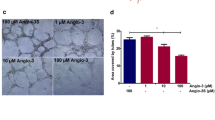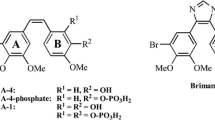Abstract
Amino acids 50–77 (p28) of azurin, a 128 aa cupredoxin isolated from Pseudomonas aeruginosa, is essentially responsible for azurin’s preferential penetration of cancer cells. We now report that p28 also preferentially penetrates human umbilical vein endothelial cells (HUVEC), co-localized with caveolin-1 and VEGFR-2, and inhibits VEGF- and bFGF-induced migration, capillary tube formation and neoangiogenesis in multiple xenograft models. The antiangiogenic effect of p28 in HUVEC is associated with a dose-related non-competitive inhibition of VEGFR-2 kinase activity. However, unlike other antiangiogenic agents that inhibit the VEGFR-2 kinase, p28 decreased the downstream phosphorylation of FAK and Akt that normally precedes cellular repositioning of the cytoskeletal (F-actin), focal adhesion (FAK and paxillin), and cell to cell junction protein PECAM-1, inhibiting HUVEC motility and migration. The decrease in pFAK and pAkt levels suggests that p28 induces a pFAK-mediated loss of HUVEC motility and migration and a parallel Akt-associated reduction in cell matrix attachment and survival. This novel, direct antiangiogenic effect of p28 on endothelial cells may enhance the cell cycle inhibitory and apoptotic properties of this prototype peptide on tumor cell proliferation as it enters a Phase II clinical trial.






Similar content being viewed by others
References
Folkman J (2006) Antiangiogenesis in cancer therapy–endostatin and its mechanisms of action. Exp Cell Res 312:594–607
Folkman J (2006) Tumor suppression by p53 is mediated in part by the antiangiogenic activity of endostatin and tumstatin. Sci STKE 2006:pe35
Lien WH, Chen CK, Lai LY, Chen YH, Wu MP, Wu LW (2004) Participation of cyclin D1 deregulation in TNP-470-mediated cytostatic effect: involvement of senescence. Biochem Pharmacol 68:729–738
Ingber D, Fujita T, Kishimoto S et al (1990) Synthetic analogues of fumagillin that inhibit angiogenesis and suppress tumour growth. Nature 348:555–557
Singh RP, Raina K, Sharma G, Agarwal R (2008) Silibinin inhibits established prostate tumor growth, progression, invasion, and metastasis and suppresses tumor angiogenesis and epithelial-mesenchymal transition in transgenic adenocarcinoma of the mouse prostate model mice. Clin Cancer Res 14:7773–7780
Singh RP, Dhanalakshmi S, Agarwal C, Agarwal R (2005) Silibinin strongly inhibits growth and survival of human endothelial cells via cell cycle arrest and downregulation of survivin, Akt and NF-kappaB: implications for angioprevention and antiangiogenic therapy. Oncogene 24:1188–1202
Wen W, Lu J, Zhang K, Chen S (2008) Grape seed extract inhibits angiogenesis via suppression of the vascular endothelial growth factor receptor signaling pathway. Cancer Prev Res (Phila) 1:554–561
Binder BR (2007) A novel application for murine double minute 2 antagonists: the p53 tumor suppressor network also controls angiogenesis. Circ Res 100:13–14
Moran DM, Maki CG (2010) Nutlin-3a induces cytoskeletal rearrangement and inhibits the migration and invasion capacity of p53 wild-type cancer cells. Mol Cancer Ther 9:895–905
Folkman J (2007) Angiogenesis: an organizing principle for drug discovery? Nat Rev Drug Discov 6:273–286
Hicklin DJ, Ellis LM (2005) Role of the vascular endothelial growth factor pathway in tumor growth and angiogenesis. J Clin Oncol 23:1011–1027
Korc M, Friesel RE (2009) The role of fibroblast growth factors in tumor growth. Curr Cancer Drug Target 9:639–651
Dempke WC, Zippel R (2010) Brivanib, a novel dual VEGF-R2/bFGF-R inhibitor. Anticancer Res 30:4477–4483
Punj V, Bhattacharyya S, Saint-Dic D et al (2004) Bacterial cupredoxin azurin as an inducer of apoptosis and regression in human breast cancer. Oncogene 23:2367–2378
Yang DS, Miao XD, Ye ZM et al (2005) Bacterial redox protein azurin induce apoptosis in human osteosarcoma U2OS cells. Pharmacol Res 52:413–421
Apiyo D, Wittung-Stafshede P (2005) Unique complex between bacterial azurin and tumor-suppressor protein p53. Biochem Biophys Res Commun 332:965–968
De Grandis V, Bizzarri AR, Cannistraro S (2007) Docking study and free energy simulation of the complex between p53 DNA-binding domain and azurin. J Mol Recognit 20:215–226
Taranta M, Bizzarri AR, Cannistraro S (2008) Probing the interaction between p53 and the bacterial protein azurin by single molecule force spectroscopy. J Mol Recognit 21:63–70
Punj V, Das Gupta TK, Chakrabarty AM (2003) Bacterial cupredoxin azurin and its interactions with the tumor suppressor protein p53. Biochem Biophys Res Commun 312:109–114
Taylor BN, Mehta RR, Yamada T et al (2009) Noncationic peptides obtained from azurin preferentially enter cancer cells. Cancer Res 69:537–546
Yamada T, Mehta RR, Lekmine F et al (2009) A peptide fragment of azurin induces a p53-mediated cell cycle arrest in human breast cancer cells. Mol Cancer Ther 8:2947–2958
Jia L, Gorman G, Coward L et al. (2010) Preclinical pharmacokinetics, metabolism, and toxicity of azurin-p28 (NSC745104) a peptide inhibitor of p53 ubiquitination. Cancer Chemother Pharmacol 1–12. doi:10.1007/s00280-010-1518-3
Ueda EK, Lo HL, Bartolini P, Walker AM (2006) S179D prolactin primarily uses the extrinsic pathway and mitogen-activated protein kinase signaling to induce apoptosis in human endothelial cells. Endocrinology 147:4627–4637
Rauth S, Kichina J, Green A, Bratescu L, Das Gupta TK (1994) Establishment of a human melanoma cell line lacking p53 expression and spontaneously metastasizing in nude mice. Anticancer Res 14:2457–2463
Tiruppathi C, Malik AB, Del Vecchio PJ, Keese CR, Giaever I (1992) Electrical method for detection of endothelial cell shape change in real time: assessment of endothelial barrier function. Proc Natl Acad Sci USA 89:7919–7923
Fong TA, Shawver LK, Sun L et al (1999) SU5416 is a potent and selective inhibitor of the vascular endothelial growth factor receptor (Flk-1/KDR) that inhibits tyrosine kinase catalysis, tumor vascularization, and growth of multiple tumor types. Cancer Res 59:99–106
Wright TJ, Leach L, Shaw PE, Jones P (2002) Dynamics of vascular endothelial-cadherin and beta-catenin localization by vascular endothelial growth factor-induced angiogenesis in human umbilical vein cells. Exp Cell Res 280:159–168
Dunphy F, Stack BC Jr, Boyd JH, Dunleavy TL, Kim HJ, Dunphy CH (2002) Microvessel density in advanced head and neck squamous cell carcinoma before and after chemotherapy. Anticancer Res 22:1755–1758
Secchiero P, Corallini F, Gonelli A et al (2007) Antiangiogenic activity of the MDM2 antagonist nutlin-3. Circ Res 100:61–69
Sheibani N, Newman PJ, Frazier WA (1997) Thrombospondin-1, a natural inhibitor of angiogenesis, regulates platelet-endothelial cell adhesion molecule-1 expression and endothelial cell morphogenesis. Mol Biol Cell 8:1329–1341
Esser S, Lampugnani MG, Corada M, Dejana E, Risau W (1998) Vascular endothelial growth factor induces VE-cadherin tyrosine phosphorylation in endothelial cells. J Cell Sci 111(Pt 13):1853–1865
Wu J, Sheibani N (2003) Modulation of VE-cadherin and PECAM-1 mediated cell-cell adhesions by mitogen-activated protein kinases. J Cell Biochem 90:121–137
Yamada T, Goto M, Punj V et al (2002) Bacterial redox protein azurin, tumor suppressor protein p53, and regression of cancer. Proc Natl Acad Sci USA 99:14098–14103
Yamada T, Hiraoka Y, Ikehata M et al (2004) Apoptosis or growth arrest: modulation of tumor suppressor p53’s specificity by bacterial redox protein azurin. Proc Natl Acad Sci USA 101:4770–4775
Ye ZM, Miao XD, Yang DS, Xu RZ, Huang X, Ge FF (2005) Selective inducement effect of bacterial redox protein azurin on apoptosis of human osteosarcoma cell line U2OS. Ai Zheng 24:298–304
Yamada T, Fialho AM, Punj V, Bratescu L, Gupta TK, Chakrabarty AM (2005) Internalization of bacterial redox protein azurin in mammalian cells: entry domain and specificity. Cell Microbiol 7:1418–1431
Schwartz JD, Rowinsky EK, Youssoufian H, Pytowski B, Wu Y (2010) Vascular endothelial growth factor receptor-1 in human cancer: concise review and rationale for development of IMC-18F1 (Human antibody targeting vascular endothelial growth factor receptor-1). Cancer 116:1027–1032
Matsumoto T, Claesson-Welsh L (2001) VEGF receptor signal transduction. Sci STKE 2001:RE21
Claesson-Welsh L (2003) Signal transduction by vascular endothelial growth factor receptors. Biochem Soc Trans 31:20–24
Gong C, Stoletov KV, Terman BI (2004) VEGF treatment induces signaling pathways that regulate both actin polymerization and depolymerization. Angiogenesis 7:313–321
Webb DJ, Parsons JT, Horwitz AF (2002) Adhesion assembly, disassembly and turnover in migrating cells–over and over and over again. Nat Cell Biol 4:E97–E100
Keezer SM, Ivie SE, Krutzsch HC, Tandle A, Libutti SK, Roberts DD (2003) Angiogenesis inhibitors target the endothelial cell cytoskeleton through altered regulation of heat shock protein 27 and cofilin. Cancer Res 63:6405–6412
Romer LH, Birukov KG, Garcia JG (2006) Focal adhesions: paradigm for a signaling nexus. Circ Res 98:606–616
Kowanetz M, Ferrara N (2006) Vascular endothelial growth factor signaling pathways: therapeutic perspective. Clin Cancer Res 12:5018–5022
Ausprunk DH, Folkman J (1977) Migration and proliferation of endothelial cells in preformed and newly formed blood vessels during tumor angiogenesis. Microvasc Res 14:53–65
DeLisser HM, Christofidou-Solomidou M, Strieter RM et al (1997) Involvement of endothelial PECAM-1/CD31 in angiogenesis. Am J Pathol 151:671–677
Lie SO, Schofield B (1973) Inactivation of lysosomal function in normal cultured human fibroblasts by chloroquine. Biochem Pharmacol 22:3109–3114
Somanath PR, Razorenova OV, Chen J, Byzova TV (2006) Akt1 in endothelial cell and angiogenesis. Cell Cycle 5:512–518
Lim ST, Chen XL, Lim Y et al (2008) Nuclear FAK promotes cell proliferation and survival through FERM-enhanced p53 degradation. Mol Cell 29:9–22
Ogawara Y, Kishishita S, Obata T et al (2002) Akt enhances Mdm2-mediated ubiquitination and degradation of p53. J Biol Chem 277:21843–21850
Cance WG, Golubovskaya VM (2008) Focal adhesion kinase versus p53: apoptosis or survival? Sci Signal 1:pe22
Kandel ES, Hay N (1999) The regulation and activities of the multifunctional serine/threonine kinase Akt/PKB. Exp Cell Res 253:210–229
Cross MJ, Claesson-Welsh L (2001) FGF and VEGF function in angiogenesis: signalling pathways, biological responses and therapeutic inhibition. Trends Pharmacol Sci 22:201–207
Bhide RS, Lombardo LJ, Hunt JT et al (2010) The antiangiogenic activity in xenograft models of brivanib, a dual inhibitor of vascular endothelial growth factor receptor-2 and fibroblast growth factor receptor-1 kinases. Mol Cancer Ther 9:369–378
Jeong SJ, Pise-Masison CA, Radonovich MF, Park HU, Brady JN (2005) Activated AKT regulates NF-kappaB activation, p53 inhibition and cell survival in HTLV-1-transformed cells. Oncogene 24:6719–6728
Cheng X, Xia W, Yang JY et al (2010) Activation of murine double minute 2 by Akt in mammary epithelium delays mammary involution and accelerates mammary tumorigenesis. Cancer Res 70:7684–7689
Acknowledgments
This work was supported through a Sponsored Research Agreement between CDG Therapeutics, Inc., and the University of Illinois at Chicago (UIC). All terms of the Sponsored Research Agreements are managed by UIC in accordance with its conflict of interest management policies.
Author information
Authors and Affiliations
Corresponding author
Additional information
Rajeshwari R. Mehta and Tohru Yamada contributed equally to this research.
Rights and permissions
About this article
Cite this article
Mehta, R.R., Yamada, T., Taylor, B.N. et al. A cell penetrating peptide derived from azurin inhibits angiogenesis and tumor growth by inhibiting phosphorylation of VEGFR-2, FAK and Akt. Angiogenesis 14, 355–369 (2011). https://doi.org/10.1007/s10456-011-9220-6
Received:
Accepted:
Published:
Issue Date:
DOI: https://doi.org/10.1007/s10456-011-9220-6




